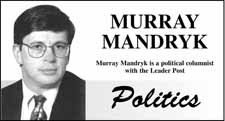Premier Brad Wall's detractors tend to criticize him for jumping into costly big-dream ideas without properly examining them first.
Of course, those more supportive of Wall would argue that his demonstrated commitment to balanced budgets, paying down general revenue fund debt and eagerness to deliver necessary-but-unspectacular infrastructure road and infrastructure improvements shows that Wall has been a prudent leader.
Nevertheless, Wall has proposed a lot of marquee, legacy projects. In less than four years, he's flirted with the notions of nuclear power plants, isotope reactors, huge carbon sequestration projects and oilsands development - none of which have really gotten much off the drawing board.
However, the clearest example of a big dream that made less economic sense was the Cadillac domed football stadium proposal at a cost of $431 million (or much, much higher) for a retractable roof. Dependent on a massive injection of either federal government or private sector support that never came to fruition, many argue that this project was a poorly conceived from the beginning.
Again, supporters argue that there's nothing wrong with Wall exploring such big ideas. After all, thinking big doesn't cost taxpayers all that much. However, when big bucks become attached to these dreams, even supporters start to take a dimmer view of them.
With that in mind, perhaps the Premier owes us a better explanation as to why Alberta-like Shock Trauma Air Rescue Service, (STARS) air ambulance helicopters still make sense.
After most everyone had thought the Sask. Party election proposal had fallen off the radar because it was too impractical and too expense, Wall announced in last year's throne speech that his government was going ahead with the plan. The Premier designated soon-to-retire former finance minister Rod Gantefoer (one of the MLAs pushing the helicopters from the beginning) as the point man. And earlier this month, Wall announced a $10-million-a-year, 10-year provincial government commitment to fund the project.
It's that $100-million financial commitment that has Wall detractors questioning whether this project is truly a good practical idea or a costly, flashy pipe dream.
Already, annual operating costs for the helicopters - initially pegged at $17- to $18 million annually - have increased to a $20-million annual pricetag because of higher costs for training for and operating the AW-139 helicopter. Add in $35- to $36 million in upfront capital costs and this has become an expense venture.
Admittedly, it's still cheaper than Alberta's STARS. Moreover, Crescent Point Energy has generously stepped forward with a four-year, $5 million commitment and PotashCorp, Mosaic, Husky Energy, Enbridge and Rawlco Radio have made yet-to-be unveiled commitments.
But while Alberta's helicopters are more expense, the provincial taxpayers' contribution (traditionally, around $4 million a year) is decided less. That's because STARS Alberta receives even bigger donations from Alberta's private sector and is further funded through things like lottery foundations.
That big $100-million Saskatchewan government commitment already suggests that Saskatchewan's version won't have same private sector financial commitment.
More critically, the need for a sizeable financial commitment from provincial coffers has many now wondering the helicopters will come at expense of the road ambulance program that many argue is already under-funded.
In fact, some are even revisiting the debate over whether the less flashy road ambulances are more effective, anyway.
Is it smart to invest this much in trauma care that could become grounded in a Prairie snow squall or frigid January day? With an extensive highway and grid road system spanning the province, are helicopters the best solution for vast, flat Saskatchewan? Will helicopters truly be faster that an ambulance network? Will they have the same paramedic support?
Wall needs to assure us that the helicopters make still a good idea and aren't coming at the expense of road ambulance service. They need to be more than just a big, flashy dream.
Murray Mandryk has been covering provincial politics for over 15 years.




